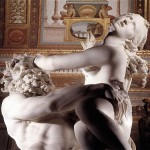My column in the latest Catholic Answer Magazine, is entitled “Mary, Mystery and Imagination”, and I explore therein the value of Catholic kitsch to a developing soul:
Because my mother was devoted to Our Lady, and also susceptible to Catholic kitsch, my childhood home was filled with small plastic statues of saints and devotional artwork that fascinated for the sheer incongruity of it.
On my bedroom wall, she had hung an image that looked for all the world as if Mary had brought the Baby Jesus in to a local photographer’s studio and posed for a portrait. The model, whose unnatural eyebrows seemed to have been inspired by Joan Crawford, wore lipstick and was dressed in Marian-blue robes, with a veil that vaguely suggested the starchy architecture of old-fashioned nun gear.
This awful image of Dita Von Teese-as-Mary, bad as it is, isn’t far off the mark of what I looked at, every night:
I loved it. My 5-year-old sensibilities missed such pronounced fakery; all I saw was a human lady, holding a human baby, and looking happy about it. Often in the evening, lying on my bed while my tumultuous family engaged in verbal rampages, I would contemplate the scene intently, noting the serenity of Mary’s brow, the chubby cheeks of the grinning Savior. Sometimes, it seemed to me her smile would broaden, as though Jesus had gurgled at her, and I felt privy to a moment of intimate joy.
Even as a child, I knew that was impossible, but as I grew older I would wonder: Could my imagination and weary eyes have been used by the Holy Spirit to communicate something reassuring to me about the depths of a parent’s love for a child? Sensible people will say no, but I’m willing to dare them and allow for mystery, because the Holy Spirit can use anything — even a bit of kitsch and our own synapses — toward God’s purposes.
In “The Story of a Soul,” St. Thérèse writes of being bedridden with fever, only to be healed after a statue of Mary seemed to smile at her. Many would read that and be justifiably skeptical; they would call her illness a psychosomatic event precipitated by the absence of a beloved sister and attribute her healing to self-hypnosis. We moderns do feel better, more secure, when we can reduce “things visible and invisible” to the ordinary with reasonable-sounding explanations.
But when has God ever been reasonable, particularly when it comes to Mary?
You can read the rest here. What sort of Catholic Kitsch did you grow up with, and do you remember any of it fondly?
In order to let you answer, I’ll open comments, even though it is Lent.











